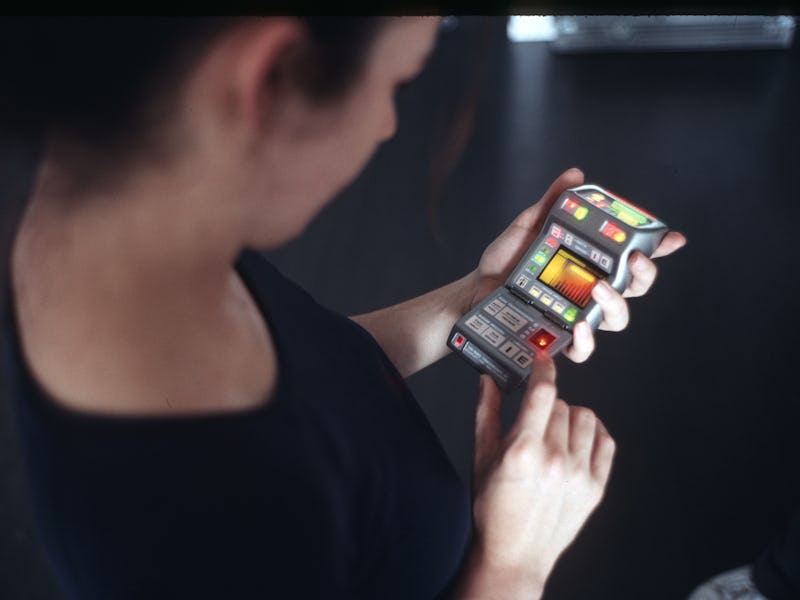Star Trek "Tricorders" Will Soon Be a Reality Thanks to XPRIZE
The competition will help people around the world live long and prosper.

Hold onto your butts, Star Trek fans. The first real-world Tricorders are about to make their debut.
Fifty years after Captain Kirk and the gang prepared to “boldly go where no man has gone before,” humanity is on the cusp of receiving its first taste of real, Star Trek medicine. Thanks to an XPRIZE foundation competition, the handy, futuristic medical device — known as a Tricorder — is one step closer to making the jump from science fiction to science fact.
In the popular science fiction series, medical officers were seen carrying around handy, pocket-sized devices that could diagnose medical conditions instantaneously. Nearly five years ago, the XPRIZE foundation — a nonprofit that aims to advance technological breakthroughs for the good of humanity — kicked off a competition to see the high-tech medical device become a reality. The proposed devices won’t be able to instantaneously diagnose diseases, but will deliver results in a period of 90 minutes to 24 hours.
“Star Trek has inspired many engineers on a quest to improve the world by turning science fiction into reality,” Paul Jacobs, executive chairman of Qualcomm — the company who is sponsoring this competition — said via the website. “The Communicator preceded the smartphone, which has revolutionized our personal interactions, and provided instant access to knowledge and entertainment.”
More than 40 teams from around the world signed up to compete for a shot in the multi-million dollar competition. Their challenge: to design and construct a real-life tricorder that can work like the device in the iconic series. This week, XPRIZE officials announced that two teams have made it to the final round of the competition and will face off for millions of dollars in funding.
The proposed devices may not look exactly like a Tricorder, but will perform similar functions.
The requirements for the competition are pretty detailed, so we’ll let you digest all the juicy engineering tidbits here. But, the goal is plain and simple: design a portable medical device that is effective, light-weight, and easy enough for the general public to use straight out of the box.
Each device weighs less than five pounds, but don’t let their diminutive size fool you — each one can monitor vital signs while simultaneously diagnosing disease. The devices are limited to what they can detect, but needless to say, are beyond cool.
According to the official site, “The winners will be the (up to) three solutions achieving the highest score in vital signs, consumer experience, and diagnostics across a set of 12 distinct diseases as well as absence of conditions. This diagnosis must be performed in the hands of a consumer, independently of a healthcare worker or facility.”
Dynamical Biomarkers Group (DBG) and Final Frontier Medical Devices have surpassed the competition and their devices are moving to a consumer trial phase as part of the final round of competition, which will take place at the Altman Clinical Translational Research Institute at the University of California San Diego. The winner will be announced in April 2017.
DBG Group's T06 device.
DBG is a group of Taiwanese researchers led by Harvard Medical School professor Chung-Kang Peng, and is backed by HTC mobile — a smartphone manufacturer and mobile technology company. As such, their device, dubbed the T06 is centered around an HTC smartphone, which features a myriad of sensors connected to the phone via Bluetooth.
Final Frontier Medical Devices is led by the doctor-engineer duo of Basil and George Harris, out of Pennsylvania. The brothers’ tricorder device, called DxtER, relies on a network of 3D-printed sensors hooked up to an iPad Mini.
Final Frontier Medical Device's Dxter device.
So what do they test for?
The instructions call for the devices to test for a host of various conditions, including anemia, atrial fibrillation, chronic obstructive pulmonary disease (COPD), diabetes, leukocytosis, pneumonia, otitis media, sleep apnea, and urinary tract infection. However, the devices must also be able to detect at least three of the following conditions: HIV, hypertension, melanoma, shingles and strep throat.
The grand prize winner takes home $6 million in funding, with second place earning $2 million. An additional $1 million will be awarded to the device that does the best job taking vital signs. And in true XPRIZE fashion, $1 million has already been awarded to teams that hit certain milestones during the competition.
Spock holding a tricorder in the original series Star Trek.
Leonard Nimoy, everyone’s favorite Vulcan, was frequently seen toting the handheld device in the iconic series. Nimoy passed away from COPD in 2015 but his legacy lives on in this competition. His daughter, Julie Nimoy, is a big fan of the competition and a champion in the fight against COPD.
She points out that, prior to his death, her father’s final mission was to raise awareness of the devastating disease. In the series, tricorders didn’t just diagnose Starfleet officers, they worked on any and all lifeforms. That’s what these two devices aim to do — provide reliable diagnostic equipment to the masses. Illness does not discriminate and once fully operational, these devices could help many people live long and prosper.